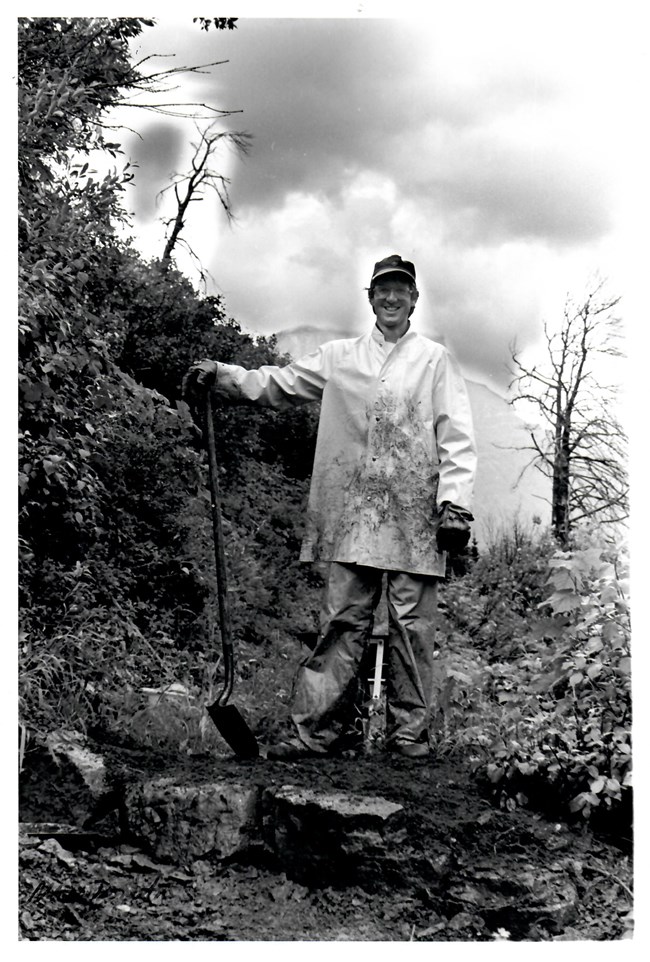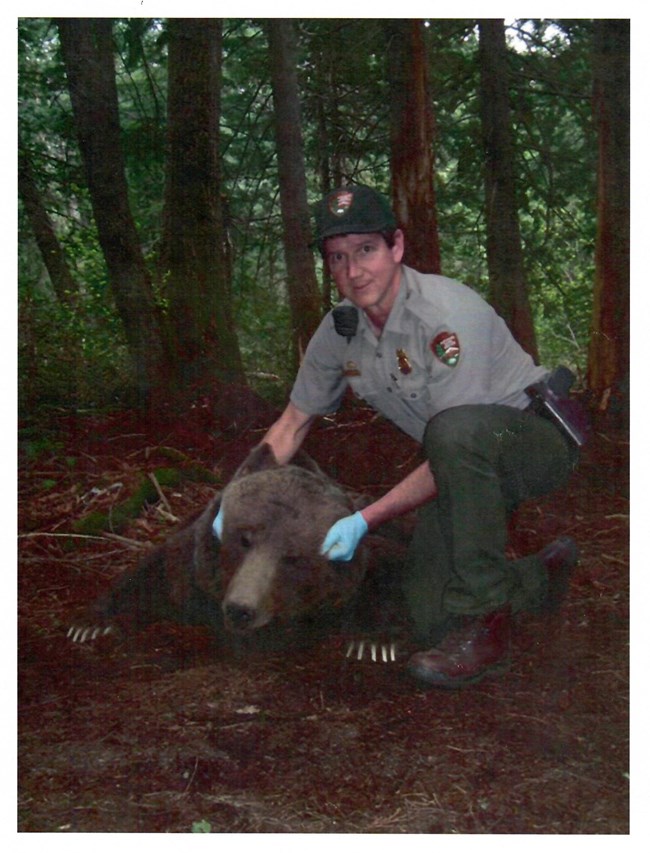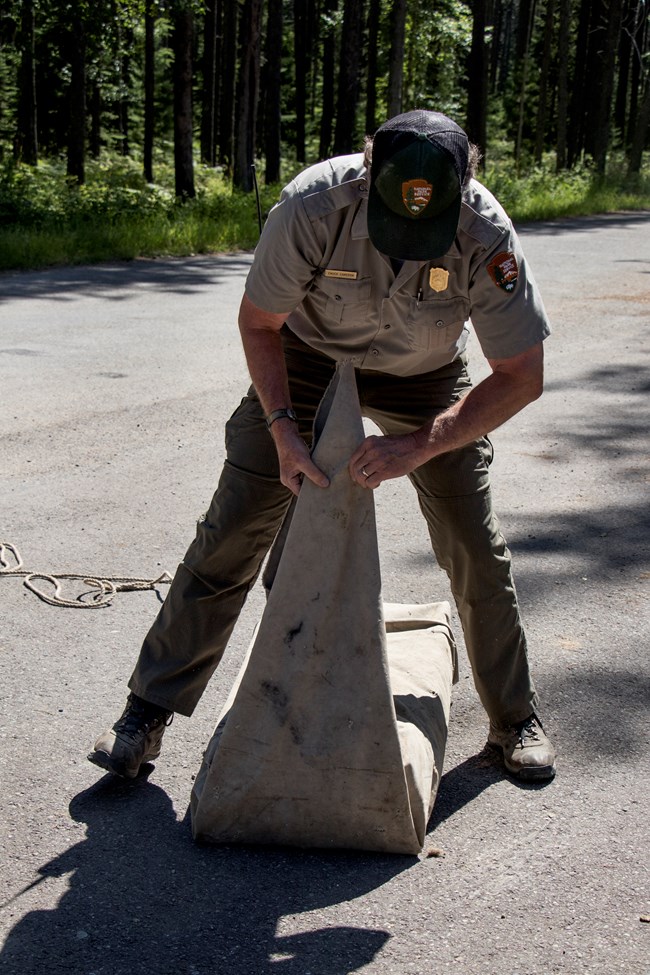what to where for a park ranger interview
By Melissa Sladek

NPS/Melissa Sladek
Experienced, knowledgeable, dedicated—seasoned. These words float through my caput every bit I spend the day with long-time resources protection ranger Chuck Cameron. I oftentimes wonder what it is most Glacier that keeps folks coming dorsum year subsequently twelvemonth. What is it about this place that creates such dynamic employees dedicated to protecting this landscape and all that lies within? For Cameron, as information technology is for many long-time Glacier National Park employees, information technology seems that working hither means something more. Glacier'southward beauty draws people in, just its essence seems to keep them here.
Glacier does have extraordinary qualities that go far special, but for folks like Cameron, those features are merely a piece of the story. Chatting with him, I find that part of what makes this identify special to Cameron are the memories—his memories. Memories of youth, memories of special bonds, memories of first-fourth dimension experiences. This place allows for those memories to happen. For those memories to stand out. For those memories to terminal a life time. And they provide the fuel for creating the dedicated stewards that Glacier is known for.

Photo courtesy of Chuck Cameron
Undoubtedly, Cameron is 1 of those stewards. Arriving in 1982, Cameron began his 30-8 year career in Glacier on the park's trail coiffure. For six years, he served the park and its visitors by clearing and maintaining trails, creating new ones, and fifty-fifty clearing the forty-mile boundary swath that separates the Usa and Canada forth the Waterton-Glacier border. After attending law enforcement academy, he switched gears and began a nine-year stint patrolling Glacier'south regal Abdomen River expanse equally a commissioned backcountry ranger.
He then moved to the Lake McDonald expanse, patrolling its backcountry for a flavor earlier existence hired in 1998 to Glacier'due south Carry Team—a team of police enforcement officers who dealt with wildlife problems, particularly bear-related incidents. The Deport Squad likewise took care of routine law enforcement work—conducting traffic stops, enforcing rules, writing tickets—merely they were given additional training in wild fauna direction, allowing them to work with deport biologists to move, capture, drug, and collar bears.

Photo courtesy of Chuck Cameron
For twenty years, Cameron came dorsum flavour after season, balancing his work in the winter on ski patrol, with his work protecting Glacier's resources and visitors in the summertime. Through the years, Cameron accrued unique skillsets, making him invaluable equally a protection ranger. I of those skillsets includes search and rescue—one of the more than challenging tasks rangers face. Cameron has been involved in most of the significant search and rescue incidents over the past four decades. He explains that these incidents become a mind game of sorts, piecing together where the lost private may have gone and why…looking for clues as to their whereabouts. Cameron goes on to state that search and rescues are challenging, non simply physically, but mentally—specially when the incident is a body recovery. Often, body recoveries hateful family or friends are on scene, and seeing the bear on on those who survive a tragic loss is one of the more difficult parts of the search.
I ask Cameron if at that place is a particular search and rescue that stands out in his memory. He reflects for a moment and begins to tell me a remarkable story. In 2008, a hiker on a solo, ten-day backcountry trip went missing. Once the hiker's family reported him missing, park personnel and other search and rescue professionals began a search for him. It was apace determined that the hiker never made it to his first camp at Sperry Campground. Roughly fifty search and rescue personnel were sent to explore all trails on the hiker's itinerary, only shortly, an expanse of Glacier known equally Floral Park became the primary focus of the search. After weeks of looking, the search was scaled back. And, although for most, the search seemed dead, Cameron informs me that for him, no missing person case is over until solved.

Photo courtesy of Chuck Cameron
It is this mental attitude that allowed Cameron and fellow rangers to finally find closure to this case 3 years later on. Cameron'south excitement level rises every bit he tells me of the remarkable serial of events that occurred during the spring of 2011. Pulled over at Moose Country, an area along the Going-to-the-Lord's day Road west of Avalanche Campground, Cameron saturday conversing with some other protection ranger. A visitor who had just been exploring higher up Barrage Lake saw the two rangers and pulled over. During his explorations, the hiker plant a pair of long underwear forth with a piece of blue nylon cloth buried in the gravel of a dry creek bed. Uncertain if these items were of any importance, the visitor asked Cameron if he wanted to run across them. Instantly, a light flickered in Cameron's brain. The location of the items and their description set off alarm bells of the missing hiker of three years back. Cameron took the bear witness, and the next mean solar day went into the area described by the company.
At the base of a couloir, lying 3,000 feet below the top, Cameron and his co-worker found more evidence. More than blue fabric (matching the description of the hiker's windbreaker), cooking gear, sleeping pad—all items matching the contents of the hiker's gear list. As the snow continued to melt that bound, additional pieces of evidence were found, including some of the hiker's basic. Cameron surmises that the hiker either fell and died or got hurt and could not be seen by search personnel. But, he adds, "Without a doubt, if the visitor had not picked up the items or stopped to show them to him, this story may not accept had an terminate." An ending that is invaluable to not simply the missing hiker's family unit members, just also for those who, like Cameron, never truly stop a search until information technology is solved.
Listening to the many stories Cameron shares with me, I am transfixed by the latitude of feel and the interesting things Cameron has done throughout his career. Simply information technology's his memories of the identify, the wildlife, and the people that stir me. The early adventures of working and exploring in Glacier's backcountry; the stories of bear captures—when everything went correct, and when information technology did not; the feeling of a grizzly bear underneath his hands; the excitement and relief of finding missing hikers; and the life-long bonds Cameron established with fellow trail crew members during his get-go years in the park. These memories stand out. They are a part of Cameron, of who he is and why he is yet hither.
Visit our keyboard shortcuts docs for details
- Duration:
- three minutes, 7 seconds
This video is well-nigh a backcountry ranger named Chuck Cameron who has worked in Glacier National Park for 38 seasons. An sound described version of this video is also available. https://www.nps.gov/rlc/crown/media.htm
These days, he is doing what he enjoys about—protecting Glacier's wilderness. In 2018, Cameron gave upwardly his constabulary enforcement commission and became the Lake McDonald backcountry ranger over again. Instead of traffic tickets and road patrols, his days are now filled with hiking the majestic terrain that caught his attention all those years agone. But the chore is more than than patrolling the trails. Cameron also maintains backcountry campgrounds, clears trails, pulls weeds, and educates backcountry users on rules, regulations, and leave no trace policies. Each day is filled with a feeling of satisfaction, knowing that his work protects the resource of this incredible place.
****
The last jiff of morning time falls away to the heat of day every bit Cameron and I step out from his truck and head toward the horse corral. Here the horses are enjoying their time off, and except for the occasional flutter in activity from those stating their identify in the pecking lodge, they seem relaxed and maybe hopeful for some other duty-gratuitous day. Unfortunately for a horse chosen Siyeh, his number is up.
Tomorrow, Cameron will need him. He'south taking Siyeh and a couple of mules to haul out sometime campground materials from the park'due south backcountry site at 50 Mountain. Today's preparation includes loading the manties (large pieces of canvas used by horse packers to wrap supplies in) for tomorrow's adventure. Not surprisingly, Cameron harbors another skillset—the art of packing. He learned how to care for and apply stock in the wilderness while working equally the Belly River ranger.

NPS/Melissa Sladek
I picket every bit he quickly, merely carefully wraps the rectangle slice of canvas around odd-shaped boxes and equipment, packaging it perfectly to keep the pelting out. Cameron informs me that this skill is a bit of dying fine art for rangers in the field. With higher visitation, more time is put into managing traffic incidents and problems in the park's front end country, making it less probable for rangers to larn skills such as these. He feels lucky that he has had such a diverse career filled with unique opportunities to help manage the park'due south wilderness as he explains, "I'm always amazed that I have this job. I've never lost sight of how lucky I am. I've gotten paid to exercise a lot of really cool things in this park."
After the manties are packed and ready for the next day's journey, we head into the field. As we drive along the sparsely traveled, dusty Within Due north Fork Road, Cameron reflects on his time in Glacier. In a manner, his career has almost come full circumvolve. He may not be forging new trails with his coiffure high upwards on a mountain pass, but he is still taking care of the park's backcountry…trails, people, wildlife, and all. And, he is nonetheless making memories, not to mention revisiting old ones—of special times he has had with special people in a special place.
Source: https://www.nps.gov/articles/interview_ranger.htm
0 Response to "what to where for a park ranger interview"
Post a Comment